
St. Francis in Ecstasy is a 1622 oil on canvas painting by Guido Reni, now in the Coppola Chapel (dedicated to the saint depicted) in Girolamini church in Naples, Italy.

St. Francis in Ecstasy is a 1622 oil on canvas painting by Guido Reni, now in the Coppola Chapel (dedicated to the saint depicted) in Girolamini church in Naples, Italy.
Its style is reminiscent of the same artist's The Mother in the Pinacoteca Nazionale di Bologna, thought to have been painted between 1615 and 1630. Reni's links to the Coppola family (if any) remain unknown. He was in Naples for ten years starting in 1612 to take part in painting the chapel of the treasure of Saint Januarius, but a 1626 inventory [1] states that the painting was not yet in the Girolamini, although Carlo Celano mentioned viewing it in the chapel in 1692. [2]
The art gallery of the Oratorians of Saint Philip Neri, known as the quadreria dei Girolamini, houses Reni's The Flight into Egypt and Jesus Meets John the Baptist . The famous clothing designer and rich textile merchant Domenico Lercaro left his whole art collection to the Oratorians in Naples (owners of the Girolamini) and a codicil to his will of 1622 states that Reni had already been paid at that date for three as-yet-undelivered works - one of John the Baptist, one of Saint Dominic and a third whose subject was not stated. A book of items leaving and joining the congregation between 1628 and 1633 mentions a Reni work arriving from his native Bologna. [3] All these pieces of evidence led us to presume that St. Francis was part of Lercaro's collection and that it was given to the Oratorians around 1630 and later placed in the chapel where it now hangs.
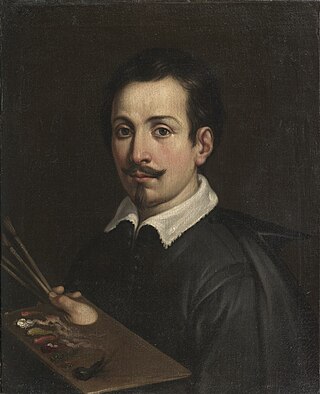
Guido Reni was an Italian Baroque painter, although his works showed a classical manner, similar to Simon Vouet, Nicolas Poussin, and Philippe de Champaigne. He painted primarily religious works, but also mythological and allegorical subjects. Active in Rome, Naples, and his native Bologna, he became the dominant figure in the Bolognese School that emerged under the influence of the Carracci.
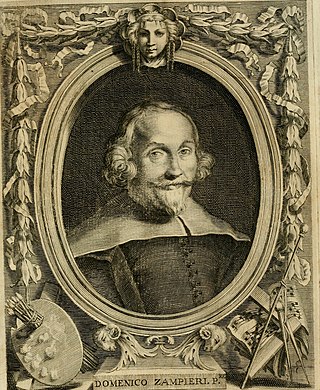
Domenico Zampieri, known by the diminutive Domenichino after his shortness, was an Italian Baroque painter of the Bolognese School of painters.

Belisario Corenzio was a Greek-Italian painter, active in Venice and Naples. He is one of few Greek painters that did not belong to the Cretan Renaissance like his contemporaries of the time. He escaped the maniera greca completely. He adopted the Venetian style. Other similar Greek painters were Marco Basaiti, Ioannis Permeniates, Antonio Vassilacchi and El Greco. He was sometimes referred to as Il Greco. His teacher was prominent Venetian painter Tintoretto. In 1590, at age 32 Corenzio settled in Naples. Corenzio was influenced by Cavalier d'Arpino. He continued to flourish in the region. His apprentices included: Luigi Rodriguez, Andrea di Leone, Onofrio De Lione and Massimo Stanzione. Corenzio painted many frescos that survived today. Some of his works are in the Church of San Severino and Certosa di San Martino. His style resembles Caravaggio. An Italian legend in Naples exists involving Corenzio, Spanish painter Jusepe de Ribera, and Battistello Caracciolo. They were referred to as the Cabal of Naples. The three painters were rumored to have poisoned their competition for painting contracts. The rumors lack documented evidence. The three painters were very popular in Naples. Corenzio frescoed the Crypt that holds the remains of Matthew the Apostle at Salerno Cathedral and it depicts scenes from the Gospel of Matthew. Corenzio was one of the most celebrated fresco painters in Naples during his time. His drawings can be found all over the world namely at the Metropolitan Museum, Museo di Capodimonte and Louvre. More recently, his life and work was studied by the Greek art historian Panayotis K. Ioannou in a comprehensive monograph.
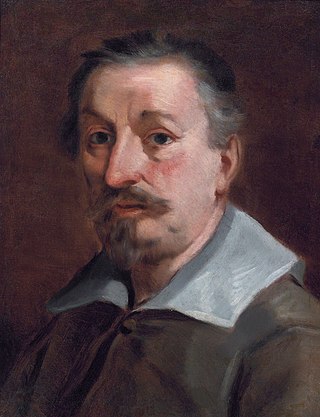
Francesco Albani or Albano was an Italian Baroque painter of Albanian origin who was active in Bologna, Rome, Viterbo (1609–1610), Mantua (1621–1622) and Florence (1633).

The Galleria Nazionale d'Arte Antica or National Gallery of Ancient Art is an art museum in Rome, Italy. It is the principal national collection of older paintings in Rome – mostly from before 1800; it does not hold any antiquities. It has two sites: the Palazzo Barberini and the Palazzo Corsini.

The Denial of Saint Peter(La Negazione di Pietro) is a painting finished around 1610 by the Italian painter Caravaggio. It depicts Peter denying Jesus after Jesus was arrested. The painting is housed in the Metropolitan Museum of Art in New York City.

The Church and Convent of the Girolamini or Gerolamini is a church and ecclesiastical complex in Naples, Italy. It is located directly across from the Cathedral of Naples on via Duomo. The facade is across the homonymous piazza and street from Santa Maria della Colonna. It is one block west of Via Duomo.

Sant'Anna dei Lombardi,, and also known as Santa Maria di Monte Oliveto, is an ancient church and convent located in piazza Monteoliveto in central Naples, Italy. Across Monteoliveto street from the Fountain in the square is the Renaissance palace of Orsini di Gravina.
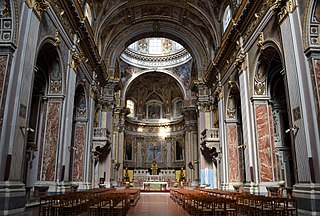
Santi Apostoli is a Baroque-style church in Naples, Italy.

The Royal Chapel of the Treasure of St. Januarius, or the Reale cappella del Tesoro di San Gennaro, is a chapel located in the Cathedral of Naples, Italy, and dedicated to St. Januarius, patron saint of the city. This is the most lavishly decorated chapel in the cathedral, and contains contributions by the premier Baroque artists in Naples.

San Giuseppe dei Ruffi or church of San Giuseppe dei Ruffo is a church located on piazzetta San Giuseppe dei Ruffi, in Naples, Italy.

The Basilica of San Giovanni Maggiore is a church in Largo San Giovanni Maggiore in central Naples, Italy.

The church of Santi Severino e Sossio and the annexed monastery are located on via Bartolommeo Capasso in Naples, Italy.

The Chiesa del Santo Rosario or Church of the Rosary is a Baroque-style, Roman Catholic church located in Piazza del Popolo in the city of Comacchio, in the province of Ferrara, region of Emilia-Romagna, Italy.

Saint John the Baptist is a c.1653-1656 oil on canvas painting by Mattia Preti, now in the Museo nazionale di Capodimonte in Naples.
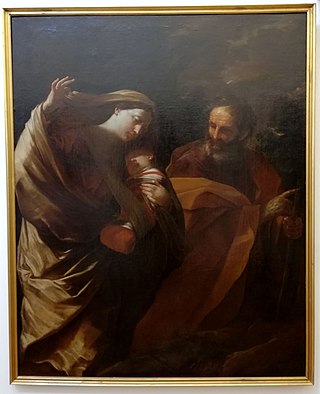
The Flight into Egypt is a c. 1622 oil on canvas painting by Guido Reni in the Girolamini, Naples in Naples.

Jesus Meets John the Baptist is a c. 1622 oil on canvas painting by Guido Reni in the Girolamini, Naples, thought to have been one of three works given to that complex by Domenico Lercaro.

The Vico, and Vicoletto, of Zuroli, more commonly called Vicolo dei Zuroli are two historic alleys located in the historic center of the city of Naples, they are located near Via Forcella, near the church of Pio Monte della Misericordia, art museum and historical place of Naples since 2005, between Via dei Tribunali and Via Vicaria Vecchia, in the Pendino district.

Baptism of Christ is a 1610-1615 oil on canvas painting by Battistello Caracciolo, now in the Girolamini, Naples.
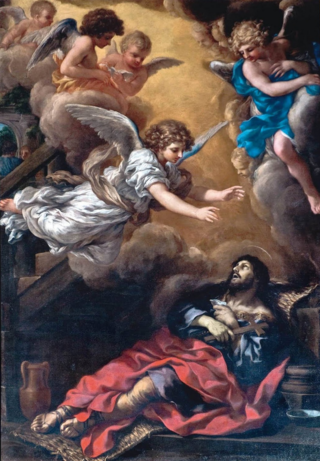
The Death of Saint Alexius or Saint Alexius Dying is an oil on canvas painting by Pietro da Cortona, created c. 1638. It is held in the Saint Alexis chapel in the Girolamini, Naples. It shows the dying saint Alexius of Rome holding a letter welcomed by angels — he had left his family and returned to them at the moment of his death, with them only recognising him thanks to the letter.